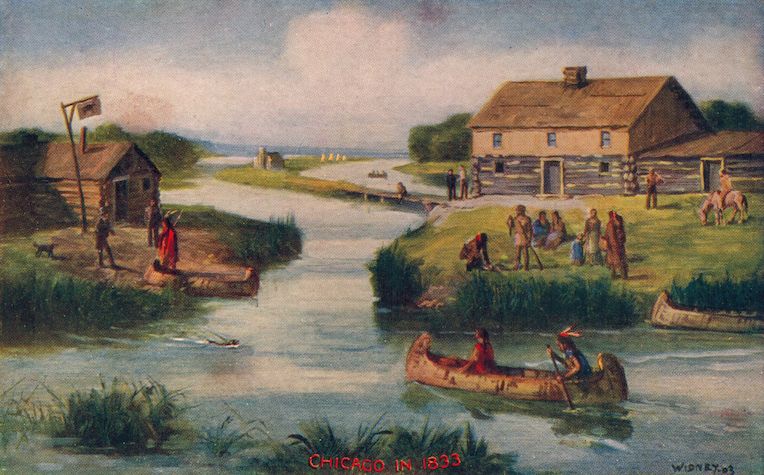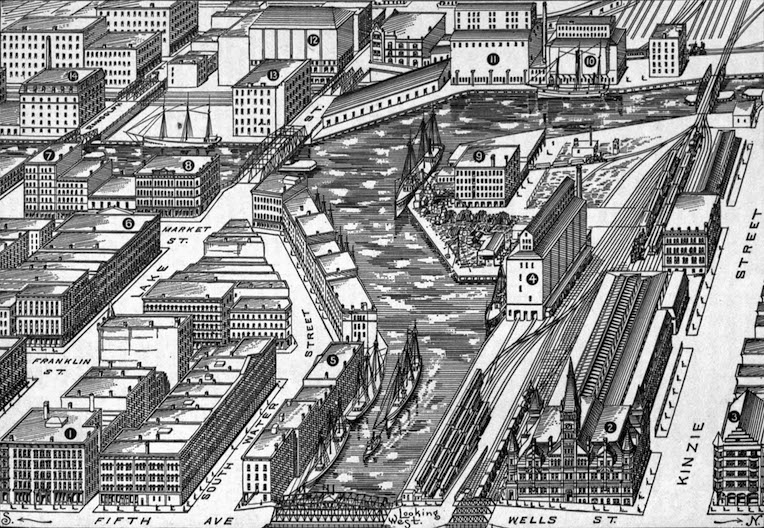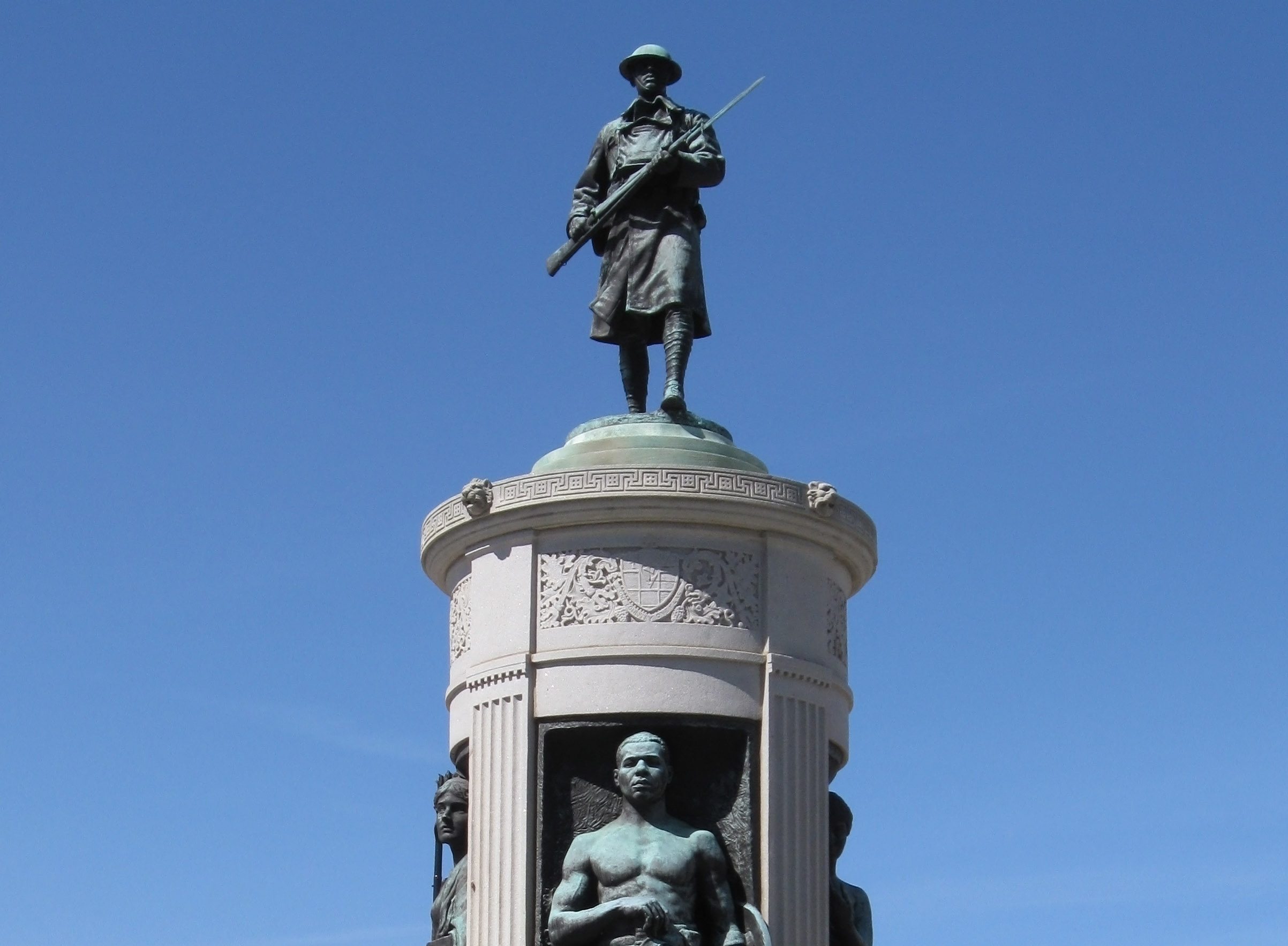Wolf Point, the Y-shaped spot where the North, South, and Main Branches of the Chicago River meet, is the at the very heart of Chicago. That junction hosted the first permanent settlement of Native Americans, French-Canadian fur trappers, and American settlers that became the city of Chicago. The ubiquitous Y-shaped municipal device that covers Chicago memorializes this location. Despite all that, Wolf Point has long been ignored – an empty patch amidst the exploding architecture and civic development of downtown. With the second phase of new skyscrapers under construction at Wolf Point, I wanted to explore the evolution of this iconic spit of land.

The (Very) Early Years of Wolf Point
The settlement which became Chicago grew up around Wolf Point in the 1810’s and 20’s. Located about a mile inland from Lake Michigan, it was the natural crossroads and resting point for traders and trappers who used the downstream Chicago Portage. At that time, Wolf Point referred to all three banks of the river at the branch’s confluence. Today, the name Wolf Point only applies to the triangle-shaped peninsula on the north bank.
Personally, I’ve always loved what a badass name Wolf Point is. It’s disappointing that the city took a name meaning “place of the wild onion/bad smell.” Just imagine how badass a prairie metropolis named Wolf Point (or Point de Loup) would have been!
The Millers brothers, Samuel and John, constructed the earliest buildings on Wolf Point. They built, in succession, a store, a tavern, and tannery on their property. In fact the tannery is the first recorded factory in Chicago history. There’s been no lack of factories since then, of course. The brothers also pitched in and helped create the first trans-river ferry. It took passengers from their tavern to the Wolf Tavern on the west bank. The ferry helped the soused traders and farmers who’d tipped their canoe trying to get across the river.
Wolf Point Is Forgotten
An institution near and dear to Chicago Detours could be found at Wolf Point in those days. The First United Methodist Church of Chicago was founded by the Rev. Jesse Walker at Wolf Point in the 1831.
That congregation moved their church building across the river to Clark and Washington in 1838. The church now calls the Chicago Temple Building its home. Guests on our Loop Interior Architecture Walking Tour learn all about this congregation and the architecture of the Chicago Temple Building.
However, Chicagoans mostly left Wolf Point empty when the city took off after its 1837 incorporation. For a long time, shipping companies used Wolf Point to store construction materials or cargo. Later developments included a warehouse and factory.
Those structures paled in comparison to their surroundings, though. On the west branch, giant grain elevators started to dot the skyline. The south bank saw a succession of buildings, such as The Wigwam, where Abraham Lincoln was nominated for President in 1860.
The Wells Street Station was built (and re-built) just to the north of Wolf Point. It serviced the exploding railroad traffic of the time. At its peak, the station served up to 32,000 passengers per day. Despite all this, Wolf Point itself remained essentially barren.

Marshall Field, the Kennedys, and New Construction
The biggest change around Wolf Point in the 20th Century was the biggest of buildings, that being the Merchandise Mart, of course. It was built by Marshall Field & Co. in 1931. It sits just northeast of Wolf Point, where the Wells Street Station once stood. The Merchandise Mart was an architectural and engineering marvel of its time, and was the largest building on the planet when it opened.
Despite that, it did not prove to be a long-term boon for Marshall Field’s. The company sold the giant structure to Ambassador Joseph P. Kennedy, the bootlegging father of President John F. Kennedy, only 14 years after it opened. The Kennedy family retained control of the Mart until the 90’s and still own the property at Wolf Point.
Despite the stewardship of deep-pocketed groups like Field’s and the Kennedys, and the gargantuan building just next door, Wolf Point remained empty. In fact, it was a parking lot for decades. I can’t help but wonder why City Hall never approached Field’s or the Kennedys about turning it into a park. Architect Fred W. Clarke said of it, “There is really nothing like this site in the world, certainly not in Chicago. It’s pivotal. It’s central. It’s waiting for its moment in history.”
At last, new construction at Wolf Point
The Kennedy family finally launched a vast new development project at Wolf Point in 2012. The plans call for trio of new skyscrapers to soar above a revitalized park and river walk space. The smallest new building, a residential high-rise named Wolf Point West topped out in 2015. The bigger towers had their architectural plans revised and revealed in 2015 as well. I love the slimmer, spire-capped new design for the south tower.
However, I also think it would be appropriate for the new developments to incorporate Wolf Point’s history a bit more. The Chicago Tribune’s architecture critic Blair Kamin made this point in 2012 and it bears repeating. Wolf Point is that pivotal, central location in Chicago and the current development there is long overdue and thrilling. I just hope that it doesn’t inadvertently bury the site’s origins.
– Alex Bean, Content Manager and Tour Guide

















